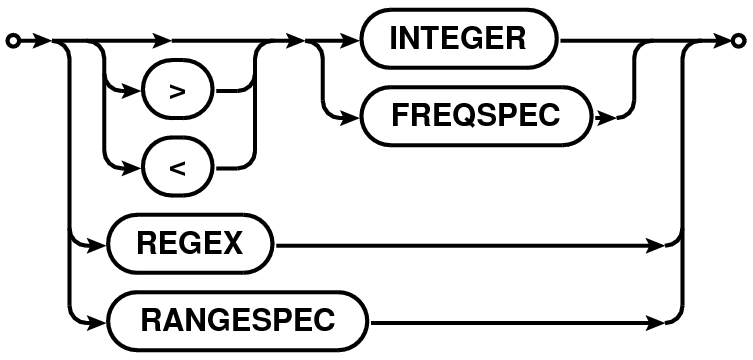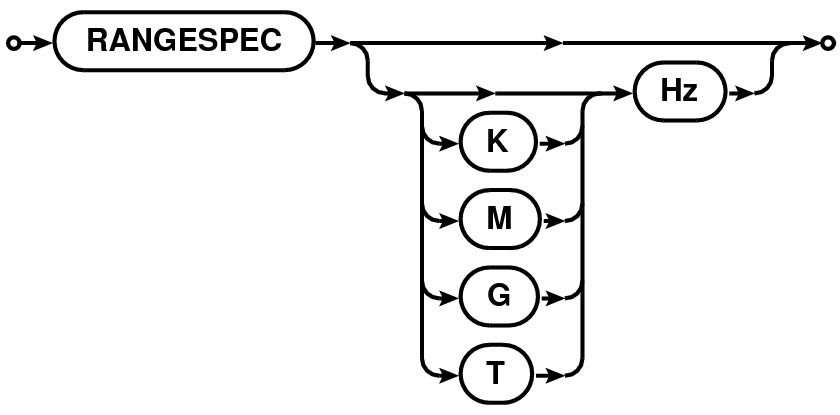| Syntax of | Railroad Diagram |
| SPWSPEC[:FREQSPEC] expression |  |
| SPWSPEC |  |
| FREQSPEC |  |
| RANGESPEC |  |
Frequency selection expression consists of two specifications separated by colon (’:’) in the form:
where SPW is the spectral window specification and FREQSPEC is the optional frequency specification for selection within the selected spectral windows. When channel specification is omitted, all channels of the selected SPW are selected.
SPWSPEC and FREQSPEC allow use of semi-colon separated lists. As a result, list of SPWSPEC can be given in two ways: (1) a semi-colon separated list, (2) coma separated list. This allows simple selections to remain simple and more complex selections consistent with the syntax for FREQSPEC list.
The full syntax is shown in the Railroad Diagram format in Table 6 and explained in the following sections.
| Syntax of | Railroad Diagram |
| SPWSPEC[:FREQSPEC] expression |  |
| SPWSPEC |  |
| FREQSPEC |  |
| RANGESPEC |  |
Spectral windows (SPW) specification can be of the following types:
SPWSPEC can be single integer, a list or a range of integers. It can also be a list of boolean expressions involving IDs. E.g.
SPWSPEC can be a name or a list of names which will be matched against the NAME column of the SPECTRAL_WINDOW. The name can be a string for literal matching, or a regular expression or a pattern. All SPWs that match the given name will be selected. E.g.
SPWSPEC can also be constructed using the reference frequency of the SPWs. The reference frequency is defined as the average of the frequency corresponding to the first and the last channel for each SPW. A single frequency specification is used for exact match with the reference frequency. A range (section 1.2) of frequencies are used to select all SPWs with the reference frequencies within the given range. The allowed units are Hz, KHz, MHz, GHz or THz. E.g.
Channel specification8 (referred to as FREQSPEC in the following description) is a START, STOP, STEP tuple corresponding to the first frequency channel, the last frequency channel and the step size to increment from the first to the last channel. The START and STOP part of the tuple can be range (section 1.2) specification for the range [START, STOP] followed by an optional STEP size.
START and STOP part of the tuple can be specified as a single integer or physical quantity or as a range (section 1.2) of integers or physical quantities. A single integer is treated as a channel index and the tuple corresponds to [ID,ID,1]. A single physical quantity is matched with the exact frequency value of the channels and tuple of matched channel index is constructed as [ID,ID,1]. A range (section 1.2) of integers given as N0~N1 is used to construct a tuple [N0,N1,1]. Similarly for a range of physical quantities.
If a START,STOP part of the tuple specification is followed by ”^STEP”, the STEP is used as the third value of the tuple. STEP specification is a single integer or physical quantity. E.g. 0~10^2 is converted to a START, STOP, STEP tuple [0,10,2].
A channel selection expression is a semi-colon separated list of channel specifications. E.g.
The specifications for SPW and channels can be combined to form a fully qualified frequency selection expression of the form SPWSPEC[:FREQSPEC] (square brackets indicate that :FREQSPEC is optional). A frequency selection expression is a comma-separated list of SPWSPEC[:FREQSPEC] specifications. Channel selections apply to all SPWs selected by the SPWSPEC on the left of ’:’. E.g.
selects
selects
Figure 1 shows an example frequency setup to motivate the need to separate the full frequency selection expression into SPWSPEC and FREQSPEC parts. SPW0 covers the frequency range 1.0–2.0 GHz with SPW1 overlapping in the range 1.6–1.7 GHz, with a reference frequency of 1.5 GHz and 1.65 GHz respectively. With independent specifications for SPW and channel selection, selection expressions can be constructed to select channels from SPW0 or SPW1 or from SPW0 and SPW1. E.g.
If a single channel specification is greater than the available outer limit, an exception is thrown. If it is less than zero, it is set to zero.